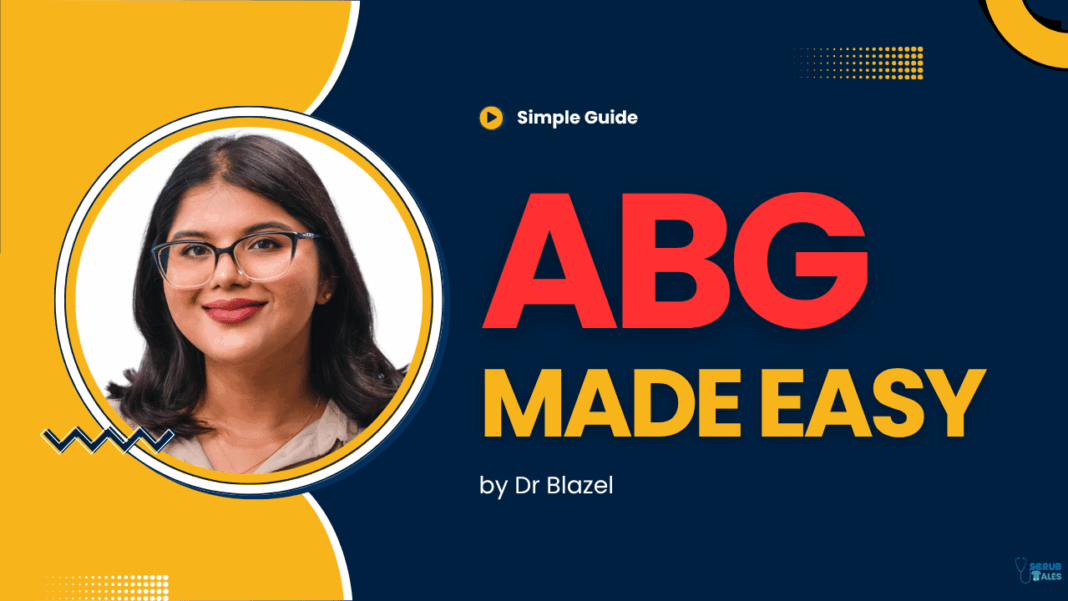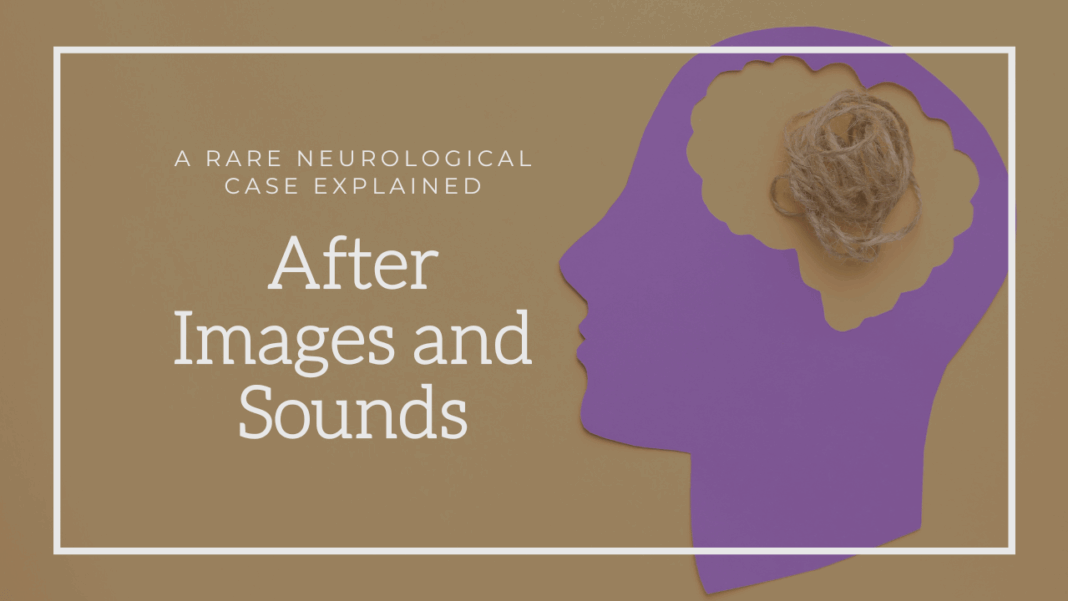After I completed PLAB 2 in 2023, I was ready to get my GMC registration and begin working in the NHS. Like many international medical graduates, I came across the idea of undertaking a clinical attachment in the UK, a period during which you shadow NHS doctors without any patient care responsibilities.
I thought, why not? It sounded like a valuable way to understand the UK’s clinical environment and how hospital teams operate on a day-to-day basis.
Clinical attachments offer IMGs a unique opportunity to observe real NHS settings– from consultations to ward rounds—without direct clinical responsibility. Although they’re not mandatory for GMC registration, they’re a brilliant way to demonstrate professionalism, learn the system, and gain confidence.
Looking back, clinical observership is more helpful before PLAB 2, especially for understanding communication styles, medical documentation, and MDT dynamics.
What is a Clinical Attachment?
Also known as Clinical Observership, it is an observer role in which international doctors shadow NHS professionals to gain an understanding of UK clinical practice.
You don’t handle patients directly. You observe ward rounds, clinics, and MDT meetings. You learn how the NHS functions—from communication styles to protocols.
Think of it as your backstage pass into the world of British healthcare.
Eligibility and Requirements for Clinical Attachment (2025)
Before you start, it’s essential to understand that clinical observership has specific eligibility criteria, particularly in NHS hospitals. The application form for a clinical attachment can only be submitted once a consultant supervisor has been secured.
Here’s what I learnt while applying:
- You must be an international medical graduate (IMG), usually within a few years of graduation.
- You need to show evidence of medical qualifications—MBBS or equivalent.
- You will need to have a named consultant supervisor responsible for your attendance during the clinical attachment. You can’t do an attachment without their support or invitation. This is why networking or knowing someone inside helps.
- Most trusts require occupational health clearance, which typically includes vaccination records and, in some cases, a physical examination.
- A DBS check (Disclosure and Barring Service) is usually not needed since attachments are observational. However, this varies from one Trust to another.
In my case, since I was on a dependent visa, I didn’t face too many issues. However, if you’re applying independently, expect to spend a few weeks completing these formalities.
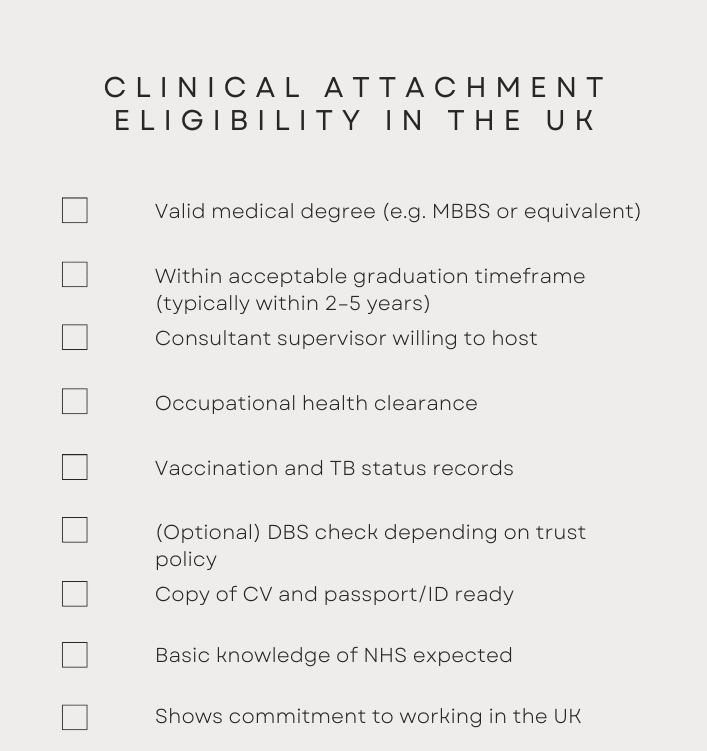
Application Process for Clinical Attachment
There are many hospitals that offer clinical attachment placements. There are some hints to finding further information, such as googling the phrase followed by Trust names. Here is one of them.
Hospitals do not generally advertise their application process publicly. Therefore, you will need to take the initiative.
Here’s how you can apply:
- Reach out directly to the department’s lead or a consultant. In some cases, a downloadable application form may be available on the Trust website.
- Submit the clinical attachment application form with a CV, proof of qualifications, and any other required documents. You must return this form to the correct email address provided by the Trust.
- Some hospitals charge a non-refundable application fee, but many don’t, especially for informal arrangements.
- Attachments have limited slots, so apply early. It may take weeks to hear back.
- A risk assessment or occupational health clearance may be conducted to evaluate your suitability for specific clinical areas (e.g., vaccinations, infection control).
In my case, I bypassed the formal application process and reached out through personal contacts. That worked for me, but if you’re applying without connections, follow the Trust’s instructions carefully. Once the clinical attachment application form has been submitted, the observer must provide evidence of consultant supervisor approval within ten working days.

My Story: Why I Chose to Do One After PLAB 2
Many doctors complete their clinical attachment before taking the PLAB 2. I did it after. Why?
Because I was already in the UK on a dependent visa—my wife was a nurse in the NHS.
Looking back, a clinical observership is more beneficial for PLAB 2 than landing your first job. It builds your practical awareness. You learn communication. You see how consultations happen.
So if I had to go back, I would’ve done it after PLAB 1, not after PLAB 2.
But I don’t regret doing it.
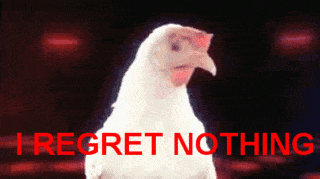
When Should You Do a Clinical Attachment?
Here’s a quick comparison to help you decide:
| Timing | Advantages | Disadvantages |
|---|---|---|
| After PLAB 1 | Prepares you for PLAB 2, builds communication confidence | Might be harder to get attachments |
| After PLAB 2 | Gives context to NHS work and job interviews | Slightly late if your goal is to boost PLAB prep |
How I Applied and Got My Attachment
I wasn’t even sure where to begin.
However, being on a dependent visa helped—I didn’t need to submit extra paperwork. My wife, who works in the NHS, helped me contact consultants at her hospital. We arranged a meeting. I sent polite, well-worded emails. I was invited to shadow a team informally.
It was unpaid. But I was in.
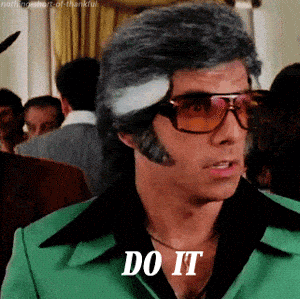
Don’t overthink it. Reach out to consultants or clinical leads for assistance. Hospitals might not advertise these. But consultants often say yes if they trust your intent.
There may be a clinical attachment application form, but initially, you have to send an email with a cover letter to apply. You can check out my post on sample cover letter with templates.
Myth Busting: Paid vs Free Attachments
There’s a trend now—paid clinical attachments with promises of job offers, certificates, or even induction letters.
Let me be honest. I don’t recommend paid attachments.
Here’s why:
- They’re expensive (£400–£1000 or more)
- They give no real extra value
- The letter you get is the same as what you’d get from a free one
- Some IMGs do 2–3 paid attachments and remain jobless
My first attachment was utterly free. The supervising consultant welcomed me. That experience, plus what I did during the attachment, mattered more than a paid certificate.
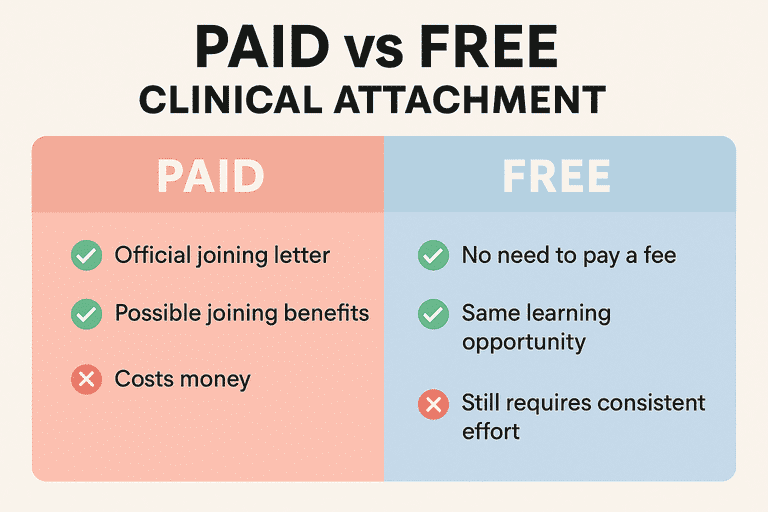
Clinical Attachment Placements and Opportunities
When I began searching for a clinical attachment, I didn’t realise how many specialities offer them. You’re not just limited to general medicine.
Choose the relevant speciality you wish to build your career in. Doing so will also benefit you in terms of prospects.
You can choose to do a clinical attachment in different specialities such as:
- Respiratory medicine
- Stroke and elderly care
- Gastroenterology
- Endocrinology
- Cardiology, oncology, rheumatology, and even surgical specialities in some trusts
You’ll typically be with one consultant-led clinical team, observing how they manage ward rounds, clinics, and meetings. Some trusts even allow you to observe teaching sessions or participate in simulation days.
Most placements are 2–4 weeks long, although extensions may be possible, depending on your rapport and consultant approval. But they’re rarely longer than 6 weeks. The maximum allowable duration for attachments can be up to two months (eight weeks).
You won’t perform any patient care, write notes, or make decisions—but you’ll observe how everything happens. That alone teaches you a lot. Clinical attachments are an observer role only and involve no direct patient contact.
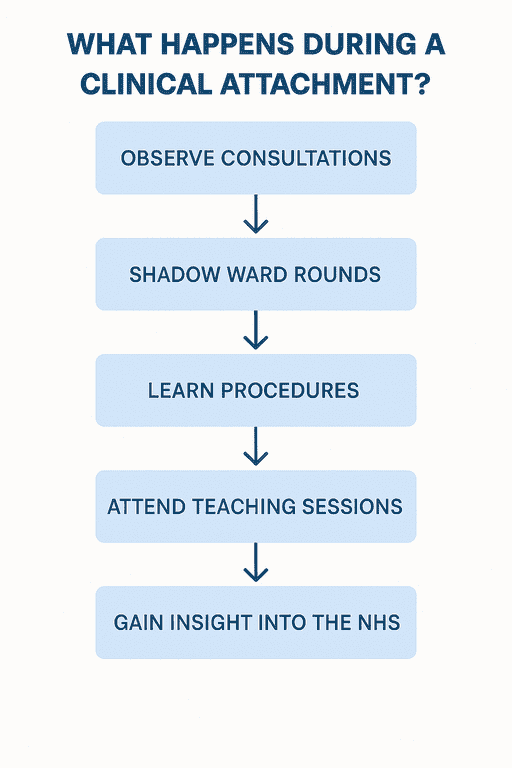
This was especially useful for me during MDTs and consultant clinics. It helped me understand the structure of care pathways and how governance policies work within NHS trusts.
Additionally, these placements provide the perfect setting to build meaningful contacts, which, for IMGs, can sometimes be more valuable than a certificate of completion.
Clinical Attachment Does Not Mean Job Offer (But It Helps)
This is the harsh truth. Completing an attachment does not guarantee a job.
But it gives you:
- UK clinical exposure
- A consultant recommendation
- NHS system understanding
- Interview prep boost
- References and application insight
It improves your chances—but only if you apply well, demonstrate initiative, and network effectively.

They say: High-calibre doctors who intend to apply for a vacant position in the Trust are prioritised for clinical attachments. I find that merely a ruse.
Roles and Responsibilities During Clinical Attachment
During the clinical observership, your primary objective is to observe and learn how the NHS operates. This means you should not be involved in the patient’s treatment.
Crucially, you are not authorised to prescribe medications, document patient notes, or make clinical decisions. But you still do things like:
- Attend ward rounds, MDT meetings, and clinics
- Observe consultations and procedures
- Ask questions (politely and at the right time)
- Watch how the team escalates concerns or refers patients
- Learn how patient histories are recorded and shared
Even without hands-on care and giving clinical advice, these observations are gold. They teach you what’s expected of a junior doctor in the NHS.
You are also expected to behave like NHS staff:
- Maintain confidentiality at all times
- Respect the hospital’s policies and dress code
- Arrive on time, follow etiquette, and maintain professionalism
Your consultant supervisor is in charge of your placement, so if you ever feel unsure, unsafe, or uncomfortable about anything, don’t hesitate to talk to them. They’re there to help and support you.
Clinical attachments enable the attachee to undertake specific duties under the supervision of a consultant following a risk assessment.
From my own experience, being proactive—without overstepping—was the key to making my attachment count.
Some people get confused between a clinical supervisor and an educational supervisor. You do not get these during observer roles, as you are neither in training nor do you undertake medical processes such as a qualified doctor in the NHS.

NHS Skills I Picked Up
You’ll be surprised how many little things matter in the NHS:
- How to bleep someone
- How discharge letters are structured
- What happens in an MDT
- Where and how to request bloods or scans
- How the e-Referral system works
None of this is in textbooks, but all of it matters in real NHS jobs and observership is a great opportunity to learn these under supervision.
Many people ask me- Can I Do An Audit During Clinical Attachment?
Well, you certainly can. There is a separate form which you have to fill as there is patient confidentiality that you have to maintain as per clinical governance guidelines.
What I Did Differently (Tips for Every IMG)
Most people treat attachments passively. I didn’t.
The problem lies in not making efforts. To make the most of it, you must make yourself visible to others.
You must reach out to recruitment leads, especially of your department and express interest in joining. Get your consultant recommendations if feasible.
Here’s what I did that I believe made a difference:
- Made strong contacts, especially with consultants
- Observed everything – from blood tests to discharge summaries
- Learned NHS basics – SBAR handovers, referrals, documentation
- Applied for jobs consistently – even during ward breaks. Aim for minimum 5-10 valuable (not just copy paste) applications.
- Talked to recruitment leads and showed interest in open roles
- Learn from other IMGs who they were successful.
I even had an FY1 doctor who became my mentor. She supported me more than anyone. You’ll find someone like that—stay humble and open.

Applying for Jobs While on Attachment
Let me say it straight: don’t just “do” the attachment and wait.
Apply for jobs every week. Every single one that fits. Don’t copy-paste applications—write tailored supporting statements.
Here’s what I did:
- Made a spreadsheet of jobs I applied to
- Used lunch breaks or MDT time to work on TRAC Jobs
- Talked to staff about recruitment pathways
- Applied to 77 jobs in total before my first interview
Yes, 77. That’s not a typo.
Preparation and Support Before Starting Your Clinical Attachment
There’s a bit of prep involved before you start shadowing. Don’t worry—it’s manageable if you know what to expect.
Before your placement begins, make sure you’ve:
- Got your MBBS or equivalent certificate ready
- Completed any occupational health clearance (including physical examination, TB status, vaccines, etc.)
- Confirmed whether a DBS check is needed—some trusts waive it for purely observer roles
- Read the hospital’s policies, especially on patient confidentiality and professionalism
- IMGs require a standard visitor visa to come to the UK for a clinical attachment. Check out our guide on the PLAB 1 visa- all the documents you will need for further information.
Most trusts will send a welcome pack or instructions once you’re accepted. This may include:
- A trust induction session
- Info on how to use ID cards or IT systems (if access is granted)
- What time to arrive and whom to report to
- Any teaching sessions or meetings you’re invited to
Some hospitals may also issue you an honorary contract for the duration of your attachment. It’s usually a formality, but it’s best to read it carefully and keep a copy for your records.
I recommend keeping a small folder with all your documents—you never know when you’ll be asked for something.
Curious about how on-calls, weekend shifts, and rotas work in the NHS? My on-call shift explainer breaks it down simply for new IMGs.
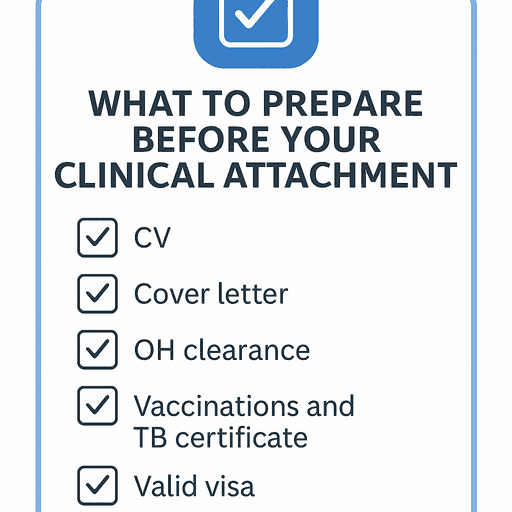
Clinical Attachment and Career Development
I had doubts whether a clinical observership would help me land my first NHS job. This is the case with everyone, especially those who pay for it.
It may not guarantee a job, but it provides you with something even more valuable: understanding and exposure.
The time I spent shadowing NHS doctors gave me confidence, not just in my communication, but in how the NHS functions behind the scenes.
A clinical observership offers a UK-based experience that enhances your CV. But other things help you as well:
- Shows commitment to NHS values, even if it’s unpaid
- Gives you material to talk about in interviews and PLAB 2 scenarios
- Provides a stepping stone towards complete GMC registration (especially if applying via non-PLAB routes)
- Offers real chances to network, ask questions, and leave a good impression
But remember: just doing an attachment won’t open doors—you have to knock hard, and sometimes more than once.
My job didn’t fall into my lap after that. I applied to 77 jobs before I got an offer. But the knowledge and contacts I gained from the attachment made that final interview easier and more confident. Also, the experience usefully contributes in developing standards expected of an NHS doctor.

What I Would Do Differently in 2025
If I were starting now in 2025, here’s what I would change:
- Do a clinical observership after PLAB 1
- Focus on communication skills early
- Record what I observed and learned daily
- Ask for feedback from the doctors I shadowed
- Reach out to multiple departments at once
- Avoid all paid attachments
- Prepare a portfolio folder to show in interviews

Conclusion
Proper clinical attachments do have value for IMGs, providing them with an opportunity to see how the NHS operates, understand the differences between hospitals, and build confidence.
I am sceptical of them and do not recommend them. Instead, I recommend having clinical experience in your home country.
No matter how lucrative they sound, the only actual value lies in preparation for PLAB 2 and full GMC registration, as well as connecting with people working in the NHS.
To make the most of it:
- Ensure you meet the eligibility criteria
- Follow the Trust’s application process carefully
- Treat it as a stepping stone—not a shortcut—to your NHS career
For me, it was the first authentic taste of the NHS—and it did make some difference.

FAQs
Is clinical attachment paid in the UK?
No, clinical observers are not paid. They are purely observational and not considered employment. Some hospitals charge a fee for processing or administration, but you won’t be earning during this period.
How long is a clinical attachment in the UK?
Most attachments last 2 to 4 weeks, although some can be extended up to 6 weeks with the supervising consultant’s approval. Duration varies depending on the hospital and department.
Does a clinical attachment count as employment?
No, it doesn’t count as employment or NHS service. You are not contracted staff. However, it still adds value to your CV and can strengthen your job applications and interviews.
What is the clinical attachment for NHS hospitals?
It’s a learning opportunity for international doctors to get real exposure to UK hospital environments, observe how care is delivered, and prepare for full GMC registration or NHS job applications.

